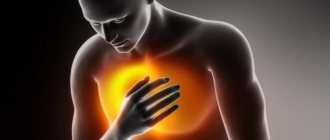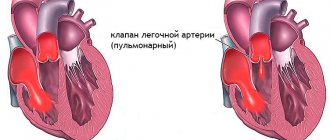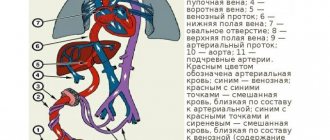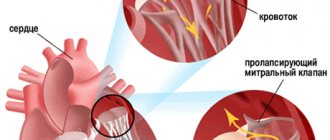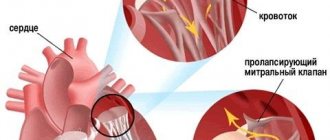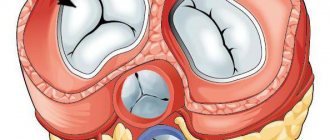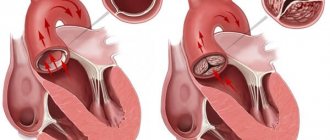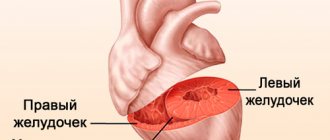Description
Pediatric mitral valve prolapse (or MVP) is a heart condition in which the doors (leaflets) located in the mitral valve can bend. As a result of this process, a partial return of blood to the left atrium from the ventricle area is observed. The stronger the blood flow, the greater the severity of the pathology. Females are more often than males susceptible to this disease, and this defect is usually detected at the age of 15-30 years.
Doctors distinguish between the primary and secondary forms of prolapse. The first case is caused by genetic abnormalities and disorders of the connective fibers of the heart. The secondary type usually develops due to diseases of the organ, and the main role in this process is played by pathologies of a rheumatological nature, inflammatory ailments in the heart muscle and injuries to the sternum. This disease often occurs without symptoms and is discovered during routine medical examinations.
Prevention
The main percentage of mitral valve diseases (stenosis, prolapse) are caused by primary infectious and rheumatic diseases. Therefore, prevention of the underlying disease is also effective as prevention of deficiency.
To eliminate the risk of intrauterine development of mitral valve insufficiency during pregnancy, appropriate safety precautions should be observed. If there is a possibility of hereditary diseases, you should plan your pregnancy and first consult a genetic specialist.
Hardening gives good preventive results in children. Increasing immunity reduces the risk of infectious diseases, in particular tonsillitis and tonsillitis, which can contribute to the development of myocarditis. For the same reason, it is necessary to monitor the condition of the child’s teeth and prevent the formation of caries.
Causes
To accurately imagine what prolapse is (bulging of the mitral valve in an adult or child), you need to clearly understand how the organ works and how it works. The heart is a pump that is designed to pump blood through the arteries of the body. In order for blood circulation to be normal, the activity of the main organ must also be harmonious, and the pressure in each part of the heart must be constant. The organ has 4 compartments, which are called chambers, and valves, which are kind of dampers that participate in the process of stabilizing the pressure and speed of blood flow in the desired direction. A person has as many valves as there are heart chambers, namely four, these are the tricuspid, aortic, as well as the mitral and pulmonary artery valves.
The location of the mitral valve is in the area between the ventricle of the heart and the atrium on the left. Chords are attached to each leaf (door) of the valve compartment, the second end of which adheres to the papillary and papillary muscle fibers. In order for the valve to function fully, the coordinated activity of all these parts of the heart, chords, valves and muscles is needed. During systole, the pressure in the heart chambers increases. The force with which this process occurs helps to open the peculiar doors of the valve, and thin chords, similar to threads, and papillary muscle fibers regulate the level of such opening. The blood flow is directed from the atrium through the leaflets built into the mitral valve, which is open at this time, then flows into the ventricular cavity and through the aortic valve to the aorta. To prevent backflow of blood, the mitral valve closing doors must close in time.
With prolapse (protrusion) of the mitral valve in adults, children or adolescents, it bulges during the period of closure. Such a violation leads to incomplete and incorrect closure of the valves, due to which a small volume of blood returns back to the left atrium. Doctors call this phenomenon regurgitation. Usually this pathological process in the organ has an insignificant course, without causing any special obstacles to the functioning of the heart and is not dangerous to human health.
Congenital or primary mitral valve prolapse is characterized by abnormalities in the development of the connective tissue from which the valves are formed. Due to the fact that these doors are weakened, they can be easily and quickly stretched, and it is difficult for them to return to their original state. Their elasticity and flexibility are significantly impaired. This pathological factor contributes to the slow elongation of the chords and the return of blood into the organ, since the valves are unable to close completely.
What can cause the congenital type:
- metabolic disorders in the expectant mother during pregnancy;
- infectious processes in the body of a pregnant woman;
- gestosis;
- genetic predisposition;
- unfavorable ecological environment;
- lack of zinc or magnesium in the body of the expectant mother;
- viral infections suffered during pregnancy;
- birth injuries of the baby;
- delivery by cesarean section.
The acquired or secondary type of the disease is much less common than the congenital one and occurs due to other heart ailments. Mitral valve prolapse caused by rheumatic lesions is more often observed in babies and slightly older children of school age. Such disorders appear due to inflammation in the tissues of the chords and valves.
What can trigger the disease:
- previous sore throat;
- viral infections, especially influenza;
- rheumatic lesions;
- endocarditis of infectious nature;
- traumatic effects on the heart;
- cardiomyopathy;
- non-rheumatic carditis;
- pericarditis;
- heart rhythm disturbances (arrhythmia);
- vegetative-vascular dystonia;
- neurological abnormalities;
- dysfunction of the thyroid gland (thyrotoxicosis).
Mitral valve prolapse can occur not only in children and adolescents; there are cases of this pathology developing in older people. Factors contributing to such disorders are myocardial infarction, as well as ischemic heart lesions. The main reasons are decreased blood supply to the papillary muscles or rupture of chordae tissue. In this case, this disease is identified on the basis of patient complaints that are characteristic of such disorders.
Mitral valve dysfunction
Mitral valve dysfunction is a concept often encountered in medical practice; it includes organic disorders, congenital and acquired. To understand what it is, you need to understand what role the mitral valve plays in the functioning of the heart.
The valve located between the left ventricle and the left atrium is called the mitral valve. The mitral valve (valva mitralis) closes at the moment of contraction of the left ventricle, preventing the return flow of blood into the left atrium.
Valva mitralis consists of two valves attached by chords; attachment is carried out by papillary and papillary muscles; this structure allows it to function effectively in two phases (systole, diastole).
Diastole (or relaxation) is characterized by the downward sagging of its valves, while allowing a flow of blood directed from the left atrium to the left ventricle.
The systole, or contraction, phase does not allow blood flow to return to the left atrium; such 100% functionality of the valva mitralis during systole cannot yet be achieved by installing a prosthesis.
Therefore, cardiologists try to preserve natural MK in every possible way.
Symptoms
A similar heart defect, which a child has from birth, often occurs together with vegetative-vascular dystonia. The symptoms are more related to this disorder specifically than to the prolapse itself.
Signs:
- Pain in the head, often disturbing in the morning and at night.
- Problems with breathing, a feeling of lack of air, the baby has a desire to take a breath as deeply as possible.
- Sleep disorder.
- The child gets tired quickly, even after minor physical and emotional stress.
- Pain in the left sternum area.
- Dizziness.
- Loss of consciousness or fainting.
When a baby experiences pain in the chest or hypochondrium, they are not related to prolapse, but are a consequence of disorders of the nervous system. It is often observed that such symptoms appear after the child has become nervous, but there are cases of such symptoms occurring for no reason. Painful sensations can usually last for several hours, less often – 2-3 days. It should be borne in mind that intense manifestations of this disease, loss of consciousness or severe lack of air are often not considered symptoms of prolapse, but indicate concomitant pathologies and heart lesions of an organic nature.
There is another important sign of such an ailment - a failure of the heart rhythm, namely, an acceleration of the beating of the organ with a feeling of its freezing. Attacks of tachycardia during prolapse differ in their course; they arise abruptly and also end unexpectedly, without symptoms of nausea or fainting. Additionally, symptoms may occur in the form of discomfort in the intestinal area or low-grade body temperature in the evenings.
The appearance of children who have this diagnosis is different. These patients are somewhat similar to each other. Usually this child has an asthenic physique, his legs and arms are thin, and his joints are mobile. Connective tissue is found in the skin, tendons, and muscles of patients. Such reasons usually enable doctors to combine these mitral valve disorders with other diseases, such as decreased visual function and strabismus.
In rare cases, children with this diagnosis experience more serious symptoms: multiple hernias that form in the groin, navel or scrotum, funnel-shaped chest. The emotional sphere of a baby’s life is also subject to change.
Often young patients suffer from psychological disorders; they are tearful, hot-tempered, and anxious. Some cases of this disease are accompanied by phobias, especially the fear of dying.
The mood of such children can change quickly, and depression often develops.
Classification
In addition to the primary and secondary forms of the disease, doctors divide mitral valve prolapse into degrees. Depending on how advanced the pathological process is, the prognosis of the disease and its treatment are determined.
Table
| Degree | Amount of prolapse |
| First | The deflection of the sash is 3-6 millimeters |
| Second | The sash can bend by 6-9 millimeters |
| Third | There is a protrusion of more than 9 millimeters |
If a child has grade 1 mitral valve prolapse, then the cusp bulges slightly. However, this determination does not affect the amount of blood that is pumped back into the heart. Therefore, it is not so important what degree of disease the child has; the main thing in diagnosing it is to identify the level of valve insufficiency and the volume of blood being thrown back. Among other things, the doctor will highlight the nature of the manifestations of the pathology, which may be asymptomatic, oligosymptomatic, or clinically significant. Systolic regurgitation with mitral valve prolapse in children also requires special attention.
Regurgitation values:
- Regurgitation in the mitral valve area.
- Regurgitation is observed in 1/3 of the left atrium.
- Regurgitation has extended to half or ½ of the left atrium.
- Regurgitation is observed in more than half of the entire left atrium cavity.
In children, this pathology often occurs in conjunction with minor cardiac anomalies, which indicates disorders and insufficient development of connective tissue. Isolated type prolapse is divided into an auscultative form, when when listening to an organ using the auscultation method, the doctor hears noise and clicks, as well as a silent form, when it is impossible to determine the presence of extraneous sounds in the heart.
Degrees of heart failure
The classification of NMV is assessed by the volume of blood returned to the left atrium, which occurs due to the lack of tightness when the valve leaflets close. There are four main groups in which the degree of reflux (regurgitation) is measured as a percentage.
- 1st degree – up to 20% of stroke volume;
- 2 degree – from 20 to 40%;
- 3 degree – from 40 to 60%;
- Grade 4 – above 60%.
The first and second degrees are considered minor and moderate, respectively. In the initial stages, it is difficult to identify the disease and make a timely diagnosis. In the first degree, blood reflux can be so insignificant that it is sometimes considered to be within the normal range. The same anatomical feature of the child’s body may be mild tricuspid valve insufficiency. Both the first and second degrees can be smoothed out for a long time, while the symptoms are mild.
The most severe fourth degree, in which the refluxed blood flow is distributed throughout the entire volume of the left atrium, is accompanied by hemodynamic disturbances.
The amount of valve bulging into the atrium gives an idea of the severity of the pathology. With heart valve prolapse, the following are noted:
- At grade 1 – bulging of the valves up to 5 mm;
- At grade 2 – the leaflets protrude into the atrium by 9 mm;
- At grade 3, the leaflets extend into the atrium by 10 mm or more.
Regurgitation is quantitatively determined by the length of the jet thrown into the atrium:
- Degree O is detected during ultrasound examination in the form of protrusion of the valves towards the atrium.
- Grade 1 regurgitation may be asymptomatic. At this stage, the length of the reverse blood flow jet does not exceed 1 cm.
- At stage 2, the disease is observed when the length of the stream does not exceed 2 cm.
- Stage 3 of the disease is characterized by a jet length of more than 2 cm.
- Stage 4 is the most severe, the stream of blood spreads over a long distance.
Diagnostics
A pediatrician or cardiologist can detect mitral valve prolapse in a baby by listening to the heart. If during this examination the doctor hears characteristic sounds, chordal squeaks, clicks or noises, he will refer the little patient for additional diagnostic measures.
Methods:
- Phonocardiography. The method allows you to find out the origin of noise in the organ.
- Ultrasound of the heart. Shows the structure of the organ and disorders in its structure from the inside.
- An ECG (electrocardiogram) is used to identify disturbances in the conductivity of an organ and its rhythm.
- X-ray examination of the heart, which is necessary to assess the condition, size and other features of the organ.
- Holter monitoring is also used to detect electrocardiographic disorders.
- Doppler echocardiography helps the doctor to identify changes in the tissues of the valve and the entire valve system, allows you to assess the degree of deflection of the valves, the severity of regurgitation, as well as the extent of hemodynamic disorders of the organ.
- Psychological tests and examination of the functioning of the central nervous system can determine the presence of autonomic disorders.
In addition to these diagnostic methods, doctors may prescribe laboratory tests and blood tests to detect the inflammatory process in the baby’s body.
Therapy
Treatment of mitral valve prolapse in children is always individual. To prescribe medications to a baby, the doctor studies examination data, pays attention to the child’s gender, age and intensity of symptoms. If a small patient has a congenital form of the disease, then there is no need to treat it, since this condition does not pose a threat to health and life. Sports are not contraindicated for these children, but it is better to engage in this activity professionally under the supervision of a doctor.
In cases of symptoms of this disease (sleep disorder or increased heartbeat), it is necessary to take herbal sedatives. These drugs will help improve the functioning of the nervous system. When more severe symptoms occur: shortness of breath, chest pain, weakness, the attending doctor will prescribe more serious medications.
If secondary prolapse is diagnosed, which has developed as a result of other diseases, then the baby is hospitalized. The inflammatory process in the valves of the organ is treated with antibacterial agents.
What medications are usually prescribed:
- "Magnesium and potassium aspartate";
- "Inosine";
- "Propanolol";
- "Atenolol";
- "L-carnitine";
- "Riboxin";
- "Coenzyme Q10".
Often it is adolescence that is conducive to the manifestation of this disease, when a child begins to play sports, he develops shortness of breath and other signs of the disease. Sometimes it is enough for such patients to undergo a course of exercise therapy and establish a daily routine, and the symptoms disappear.
Physiotherapy:
- electrophoresis;
- therapeutic massages;
- galvanization;
- Darsonvalization.
The daily regimen of patients should be correct, sleep should be complete, and the diet should be rich in useful elements, then the prognosis of the disease will be favorable.
In severe cases of prolapse, surgical treatment is necessary, when cardiac surgeons perform valve replacement or plastic correction of the heart.
Causes of pathology
Mitral valve pathology is a common disease, observed mainly in adolescents. The disease is detected much more often in girls than in boys. In the presence of prolapse, the heart valve leaflets do not close tightly enough, allowing blood to flow back into the atrium, which causes disruption of the heart and affects blood circulation.
The disease can be congenital or acquired. Acquired as well as congenital mitral valve prolapse in children is detected more often at the age of 7-15 years. The birth defect is hereditary and is passed on to the child from the mother.
Congenital prolapse
The appearance of signs of diseases caused by dysfunction of the mitral and tricuspid valves is associated with:
- With features of the development of cardiac tissues;
- Deformations of the valves, peculiarities of attachment;
- With impaired innervation of the valves due to dysfunction of the autonomic nervous system.
The cause of the disease in children may be a disproportion in size, expansion of the mitral ring, or improper attachment of the valves to the wall of the heart. Disturbances in the development of connective tissue are inherited, manifested in strong extensibility of the valves and elongation of the cardiac chords. The course of the defect is generally favorable; it is more a feature of the body than a disease.
Congenital pathology of the mitral valve is often combined with vegetative-vascular dystonia and manifests itself with similar symptoms.
Acquired vice
Heart valve disease can cause diseases of the autonomic nervous system and changes in the psycho-emotional sphere. The cause of the pathology may be trauma in the chest area. The chord rupture caused by the impact causes the valve to tear off, disrupting the fit of the valves. The disease is usually severe and requires surgical treatment.
Mitral valve prolapse acquired during life in children often occurs with rheumatic heart disease. The disease occurs as a result of inflammation of the chords and valves caused by tonsillitis and scarlet fever. These infectious diseases can cause damage to the heart valves and an attack of rheumatism.
Children with mitral valve disease have an asthenic build, tall stature, and poorly developed muscles. Such children are distinguished by flexibility and mobility in the joints. Girls are often blonde-haired and blue-eyed. Children with a congenital defect experience mood swings, fatigue, tearfulness, and anxiety. Children are prone to depression and develop phobias, including the fear of death. Symptoms often do not correspond to the severity of prolapse; the prognosis of the disease is favorable.
To improve their condition, children with prolapse need to be provided with a correct daily routine, adequate sleep, and a calm, friendly environment in the family.
Inadequate development of connective tissue manifests itself among close relatives of the child as varicose veins, scoliosis, hernias, myopia, and strabismus. You can assume that a child has a disease if he has frequent sore throats and colds. Pathological conditions observed in children:
- Stitching short-term pain in the chest;
- Palpitations with a feeling of irregular rhythm;
- Headache after a night's sleep;
- Dizziness after standing up suddenly;
- Tendency to faint.
Fainting is quite rare and is caused by staying in a stuffy room and strong emotions. All pain symptoms appear in a child after strong emotional experiences, overwork and are well eliminated with valerian, valocordin or other sedatives.
Prevention and prognosis
The course of the disease is usually benign; severe consequences are rare. It is important to visit your doctor regularly and undergo timely examination. Proper treatment will help avoid complications. Modern medicine can eliminate such a disease, so children with mitral valve prolapse have the opportunity to live a full life.
Preventive measures include following all recommendations of the treating doctor and taking prescribed medications. A daily routine and a correct lifestyle will help improve the patient’s well-being and get rid of unpleasant sensations. If a woman has planned a baby, then she needs to prepare for pregnancy. In order to protect your unborn child as much as possible, you must, if possible, protect yourself from stress, colds and completely give up bad habits.
Mitral valve prolapse has already been sufficiently studied, so doctors can cure the disease or save the baby from its manifestations and serious consequences. Regular visits to the doctor will allow you to identify the pathology at an early stage and begin treatment on time, then the prognosis will be comforting.
Prolapse of the anterior leaflet of the mitral valve: treatment in children and adults
If MVP is accompanied by severe symptoms, then they can be eliminated with the help of selected therapy. In some cases, it is possible to remove the signs of pathology, in others, to reduce their severity. Treatment is prescribed individually, taking into account the characteristics of the body, age, gender, and genetic factors.
The choice of drugs depends on the severity of the clinical course of the disease. Typically, patients of different ages are prescribed the following groups of medications:
- Sedatives - if the symptoms are affected by a disorder of the autonomic nervous system;
- Beta blockers - help restore heart rhythm;
- Nutrients – to improve myocardial function;
- Anticoagulants – prevent the formation of blood clots in the atria.
But the main importance is adjusting the patient’s lifestyle. First of all, the degree of mental stress is normalized, which must be combined with physical exercise. To accurately adjust sports activities, you need to go to physical therapy, where an experienced specialist will select the best gymnastics complex for an individual. It's good to go to the pool for swimming.
In childhood, it is important to ensure that the child does not overexert himself nervously and mentally, as this will aggravate the pathology and cause chronic fatigue. To do this, parents need to adjust their study, work and rest schedules. From time to time, children are sent to sanatoriums, where they will receive specialized massages, mud treatment, acupuncture, etc.
For some patients, it is advisable to use herbal medicine. Doctors may recommend sedative herbal remedies - motherwort, St. John's wort, sage. Horsetail and ginseng are also used.
Medicines that may be prescribed include:
- Cinnarizine - to improve blood microcirculation;
- Cardiometabolites - to increase metabolic processes (Riboxin, ATP);
- Beta-blockers - if the patient has a rapid heartbeat;
- Antiarrhythmic drugs (usually prescribed for grade 3 MV prolapse);
- Vitamins, minerals.
Also, for metabolic disorders, various physiotherapeutic procedures are used, which are selected on an individual basis. Surgical intervention is indicated only for the last degree of MVP.
In childhood, patients with mitral valve prolapse should be registered with a cardiologist. They should see a specialist every six months in order to promptly detect worsening pathology and promptly begin effective treatment. Physical exercises can be performed by almost all children, but with grades 2 and 3 of the disease they must be reduced, and in severe cases they must be limited.
